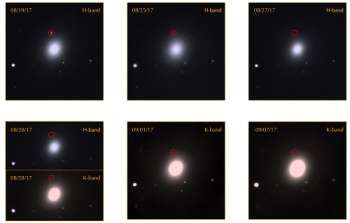sci17104 — Announcement
Astronomers Feast on First Light From Gravitational Wave Event
October 19, 2017
The image sequence above shows infrared imaging from the FLAMINGOS-2 imager and spectrograph for a period of over two weeks. The top row features images in the h-band, a shorter (bluer) wavelength of infrared light. The bottom row focuses mostly on k-band images, which are longer (redder) wavelengths of light. This sequence reveals how the object became redder as it faded from view.
Gemini Observatory "pulled all of the stops" to bring a gravitational wave source into focus and capture early optical and infrared light from the merger of two neutron stars. The critical ground-based observations spanned almost a month during the summer of 2017 and allowed astronomers to dissect the first electromagnetic light emissions ever associated with a gravitational wave event. More details can be found on the Gemini press release.
About the Announcement
| Id: |
ID
sci17104
|
